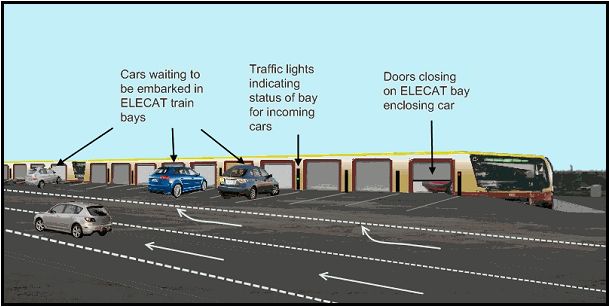
The rail version of the ELECAT uses an electrically powered train composed of car carrying carriages, which
are separated into vehicle compartments. As with the road ELECAT, the vehicles are driven in and out of these
compartments sideways, however, there is no need to rotate them since the carriage is wide enough to
accommodate the car, so they remain at right angles to the direction of travel during transit (see figure 24). The
cars on the rail ELECAT would be charged on route using a direct connection to the mains supply rather than an
IC engine driven generator.
A 300 metre long train, with a cross section approximately 1.5 metres high by 4.5 metres wide could house
about 100 cars, and one such train every minute would be able to replace the entire vehicle capacity of a 3 lane
carriageway. However, using 2 lines per carriageway would substantially improve flexibility by allowing
separate medium and high speed lines. The medium speed line would stop at all the junctions, whilst the high
speed version stops only at major junctions to maintain a higher speed. The use of two lines would also enable a
degree of redundancy, so repair of one line would not stop the entire ‘carriageway’. Lower speed metropolitan
lines could also be built to intersect the high speed lines at junctions so cars could be dropped off at strategic
points such as ring-roads and car parks inside the town or city bypassing the road system. Note that the rail
ELECAT lines would be largely independent of one another to minimise the need for rail points or switches, so
cars would drive off one train and onto another at the junctions to change lines.
Figure 24 Vehicle transfer station for rail ELECAT
The cars wait on a platform in an assigned bay. On arrival of the ELECAT train the doors open and the cars
drive in the carriages sideways and remain in that position during transit. At their destination the cars drive out
the opposite side of the carriage.
The number of carriages carried by each ELECAT train would be varied to maintain efficient utilisation
throughout the day and to avoid unnecessary weight. In addition, the trains would allow regenerative braking to
reclaim back the kinetic energy when decelerating. The aerodynamic resistance would be much lower than the
road version of the ELECAT in relation to the capacity carried due to the length and superior aerodynamics
allowed by using a long train of carriages. This combination of measures should allow the rail ELECAT to
attain much higher energy efficiency and lower carbon emissions per vehicle km than when either driving the
vehicles individually along the road or when the cars are travelling on a road ELECAT. Ultimately, the power
stations supplying this electricity could be supplied from low carbon sources enabling a completely sustainable
private vehicle sector.
The ELECAT could also include the option of using a passenger carriage in addition to the car transporter
carriages. With this option it is envisaged that passengers would travel to the transfer station in a BEV and park
there, travel as a passenger in the ELECAT, then re-embark in an BEV at the transfer station and drive to their
specific destination. These cars would be interchangeable between drivers and maintained and owned externally.
The use of rail system on the highway is justified by the high demand for ‘car’ based travel, this would operate
in an analogous way to a metropolitan subway by supplying a continuous supply of carriages for mass use. This
would ensure its extensive use, efficient utilisation and economic viability. More generally, the road and rail
ELECAT concepts are based on the realistic assumptions that the private vehicle will remain the only
practical method of time efficient transport outside the most densely populated areas, and electrification
of the private transport network would be necessary to reduce or eliminate CO2 emissions. It avoids the

